COMPUTER ENGLISH
计 算 机 英 语
(第 2 版)
刘艺 王春生 编
�
计算机英语 1
Part One
Computer Basics
�
2 Computer English
第一部分
计算机基础
第一单元
我的电脑
第二单元
计算机硬件结构
第三单元
操作系统
第四单元
计算机语言与编程
● 课文 A:计算机概览
● 课文 B:可穿戴的计算机
● 课文 C:PDA 拳击赛:Palm
对 Pocket PC
● 课文 A:计算机硬件
● 课文 B:通用串行总线
● 课文 C:DVD
● 课文 A:操作系统
● 课文 B:Longhorn:Windows 的
下一个版本
● 课文 C:什么是 Linux
● 课文 A:编程语言
● 课文 B:Java 语言
● 课文 C:数组
�
计算机英语 3
Unit 1: My Computer
(我的电脑)
Section A
Computer Overview
I. Introduction
A computer is an electronic device that can receive a set of instructions,
or program, and then carry out this program by performing calculations on
numerical data or by manipulating other forms of information.
The modern world of high technology could not have come about1
except for the development of the computer. Different types and sizes of
computers find uses throughout society in the storage and handling of data,
from secret governmental files to banking transactions to private
household accounts. Computers have opened up a new era in manufacturing
numeric(al)
/ nju:5merik(El) /
a. 数字的;数值的
manipulate
/ mE5nipjUleit /
v. 操作;处理
transaction
/ trAn5zAkFEn /
n. 交易;业务;事
务(处理)
1 come about:发生,产生。
�
4 Computer English
automation
/ 7C:tE5meiFEn /
n. 自动化
enhance / in5hB:ns /
v. 增强
conjecture
/ kEn5dVektFE /
n. 推测,猜想
database
/ 5deitEbeis /
n. 数据库
privacy / 5praivEsi /
n. 隐私;秘密
precursor
/ 7pri:5kE:sE /
n. 先驱
digit / 5didVit /
n. 数字
loom / lu:m /
n. 织机
perforated
/ 5pE:fEreitid /
a. 穿孔的
conceive / kEn5si:v /
v.(构)想出
punched card
穿孔卡片
electrical contact
电触点
compile / kEm5pail /
v. 汇编;编译
census / 5sensEs /
n. 人口普查
analytical
/ 7AnE5litikEl /
a. 分析的
Analytical Engine
分析机,解析机
through the techniques of automation, and they have enhanced modern
communication systems. They are essential tools in almost every field of
research and applied technology, from constructing models of the universe
to producing tomorrow’s weather reports, and their use has in itself opened
up new areas of conjecture. Database services and computer networks
make available a great variety of information sources.1 The same advanced
techniques also make possible invasions of personal and business privacy.
Computer crime has become one of the many risks that are part of the price
of modern technology.
II. History
The first adding machine, a precursor of the digital computer, was
devised in 1642 by the French scientist, mathematician, and philosopher
Blaise Pascal2 This device employed a series of ten-toothed wheels, each
tooth representing a digit from 0 to 9. The wheels were connected so that
numbers could be added to each other by advancing the wheels by a correct
number of teeth. In the 1670s the German philosopher and mathematician
Gottfried Wilhelm Leibniz3 improved on this machine by devising one that
could also multiply.
The French inventor Joseph-Marie Jacquard 4 , in designing an
automatic loom, used thin, perforated wooden boards to control the
weaving of complicated designs. During the 1880s the American statistician
Herman Hollerith5 conceived the idea of using perforated cards, similar to
Jacquard’s boards, for processing data. Employing a system that passed
punched cards over electrical contacts, he was able to compile statistical
information for the 1890 United States census.
1. The Analytical Engine
Also in the 19th century, the British mathematician and inventor
Charles Babbage6 worked out the principles of the modern digital computer.
1 Database services and computer networks make available a great variety of information sources.:数据库服务和
计算机网络使各种各样的信息源可供使用。这句话由于宾语(a great variety of information sources)较长,
因此将宾语的补语(available)放到了宾语的前面。文中下一句话也属同样情况。
2 Blaise Pascal:布莱斯·帕斯卡(1623~1662),法国数学家、物理学家、哲学家,概率论创立者之一。
3 Gottfried Wilhelm Leibniz:戈特弗里德·威廉·莱布尼兹(1646~1716),德国自然科学家、哲学家,微
积分、数理逻辑的先驱,提出了二进制。
4 Joseph-Marie Jacquard:约瑟夫―玛丽·雅卡尔(1752~1834),法国著名的织机工匠,纹板提花机的主
要改革家。
5 Herman Hollerith:赫尔曼·何勒里斯(1860~1929),美国发明家和统计学家。
6 Charles Babbage:查尔斯·巴比奇(1792~1871),英国数学家和发明家。
�
计算机英语 5
Difference Engine
差分机
input stream
输入(信息)流
analog(ue)
/ 5AnElCg /
a. 模拟的
shaft / FB:ft /
n. 轴
approximation
/ E7prCksi5meiFEn /
n. 近似(值)
computing
/ kEm5pju:tiN /
n. 计算(技术)
torpedo / tC:5pi:dEu /
n. 鱼雷
submarine
/ 7sQbmE5ri:n /
n. 潜艇
bombsight
/ 5bCmsait /
n. 轰炸瞄准器
incorporate
/ in5kC:pEreit /
v. 包含,吸收;把…
合并,使并入
vacuum tube
真空管
crack / krAk /
v. 破译
encipher / in5saifE /
v. 把…译成密码
prototype
/ 5prEutEtaip /
n. 原型;样品
He conceived a number of machines, such as the Difference Engine, that
were designed to handle complicated mathematical problems. Many
historians consider Babbage and his associate, the mathematician Augusta
Ada Byron1, the true pioneers of the modern digital computer. One of
Babbage’s designs, the Analytical Engine, had many features of a modern
computer. It had an input stream in the form of a deck of punched cards, a
“store” for saving data, a “mill” for arithmetic operations, and a printer that
made a permanent record.2 Babbage failed to put this idea into practice,
though it may well have been technically possible at that date.
2. Early Computers
Analogue computers began to be built in the late 19th century. Early
models calculated by means of rotating shafts and gears. Numerical
approximations of equations too difficult to solve in any other way were
evaluated with such machines. Lord Kelvin 3 built a mechanical tide
predictor that was a specialized analogue computer. During World Wars I
and II, mechanical and, later, electrical analogue computing systems were
used as torpedo course predictors in submarines and as bombsight
controllers in aircraft. Another system was designed to predict spring floods
in the Mississippi River4 basin.
3. Electronic Computers
During World War II, a team of scientists and mathematicians,
working at Bletchley Park, north of London, created one of the first
all-electronic digital computers: Colossus5. By December 1943, Colossus,
which incorporated 1,500 vacuum tubes, was operational. It was used by
the team headed by Alan Turing6, in the largely successful attempt to crack
German radio messages enciphered in the Enigma code7.
Independently of this, in the United States, a prototype electronic
1 Augusta Ada Byron:奥古斯塔·埃达·拜伦(1815~1852),英国数学家,诗人拜伦之女。
2 It had an input stream in the form of a deck of punched cards, a “store” for saving data, a “mill” for arithmetic
operations, and a printer that made a permanent record.:它有一个以一叠穿孔卡片的形式存在的输入流、一
个存储数据的“仓库”、一个进行算术运算的“工厂”和一台产生永久记录的打印机。
3 Lord Kelvin:开尔文勋爵(1824~1907),全名威廉·汤姆森·开尔文(William Thomson Kelvin),英国
物理学家,发展了热力学理论,创立了热力学绝对温标(即开尔文温标)。
4 Mississippi River:密西西比河,发源于美国中北部的湖沼区,南注墨西哥湾,系美国主要河流。
5 Colossus:该词读作 / kE5lCsEs/ ,有“巨像”、“巨人”、“巨物”等意。
6 Alan Turing:艾伦·图灵(1912~1954),英国数学家和逻辑学家。
7 Enigma code:恩尼格码,德军在第二次世界大战期间采用的一种密码。
�
6 Computer English
overshadow
/ 7EuvE5FAdEu /
v. 使相形见绌
integrator
/ 5intigreitE /
n. 积分器
patent / 5peitEnt /
n. 专利(权)
overturn
/ 7EuvE5tE:n /
v. 推翻;废除
Hungarian
/ hQN5geEriEn /
a. 匈牙利的
memory / 5memEri /
n. 存储器,内存
paper-tape reader
纸带阅读器
execution
/ 7eksi5kjuFEn /
n. 执行,运行
machine had been built as early as 1939, by John Atanasoff1 and Clifford
Berry2 at Iowa State College3. This prototype and later research were
completed quietly and later overshadowed by the development of the
Electronic Numerical Integrator And Computer (ENIAC 4 ) in 1945.
ENIAC was granted a patent, which was overturned decades later, in 1973,
when the machine was revealed to have incorporated principles first used in
the Atanasoff-Berry Computer.
Figure 1A-1: ENIAC was one of the first fully electronic digital computers
ENIAC (See Figure 1A-1) contained 18,000 vacuum tubes and had a
speed of several hundred multiplications per minute, but originally its
program was wired into the processor5 and had to be manually altered.
Later machines were built with program storage, based on the ideas of the
Hungarian-American mathematician John von Neumann6. The instructions,
like the data, were stored within a “memory”, freeing the computer from
the speed limitations of the paper-tape reader during execution and
1 John Atanasoff:约翰·阿塔纳索夫(1903~1995),美国物理学家。
2 Clifford Berry:克利福德·贝里(1918~1963),美国物理学家。
3 Iowa State College:(美国)艾奥瓦州立学院。
4 ENIAC:电子数字积分计算机,ENIAC 计算机(Electronic Numerical Integrator And Computer 的首字母缩略)。
5 its program was wired into the processor:程序通过导线传送到处理器内。
6 John von Neumann:约翰·冯·诺伊曼(1903~1957),美籍匈牙利数学家,对量子物理、数学逻辑和高
速计算机的发展均有贡献。
�
计算机英语 7
permitting problems to be solved without rewiring the computer.
The use of the transistor in computers in the late 1950s marked the
advent of smaller, faster, and more versatile logical elements than were
possible with vacuum-tube machines. Because transistors use much less
power and have a much longer life, this development alone was responsible
for
second-generation computers.
Components became smaller, as did inter-component spacings, and the
system became much less expensive to build.
improved machines called
the
4. Integrated Circuits
Late in the 1960s the integrated circuit, or IC (See Figure 1A-2), was
introduced, making it possible for many transistors to be fabricated on one
silicon substrate, with interconnecting wires plated in place1. The IC
resulted in a further reduction in price, size, and failure rate. The
microprocessor became a reality in the mid-1970s with the introduction of
the large-scale integrated (LSI) circuit and, later, the very large-scale
integrated
thousands of
interconnected transistors etched into a single silicon substrate.
(microchip), with many
(VLSI) circuit
Figure 1A-2: An integrated circuit
To return, then, to the switching capabilities of a modern computer:
computers in the 1970s were generally able to handle eight switches at a
time. That is, they could deal with eight binary digits, or bits, of data, at
transistor
/ trAn5sistE /
n. 晶体管
advent / 5Advent /
n. 出现,到来
versatile / 5vE:sEtail /
a. 多用途的,
通用的
logical element
逻辑元件
fabricate
/ 5fAbrikeit /
v. 制作
silicon / 5silikEn /
n. 硅
substrate
/ 5sQbstreit /
n. 衬底,基底
microprocessor
/ 7maikrEu5prEusesE /
n. 微处理器
microchip
/ 5maikrEutFip /
n. 微芯片
etch / etF /
v. 蚀刻
binary / 5bainEri /
a. 二进制的
bit / bit /
n. 位,比特
1 making it possible for many transistors to be fabricated on one silicon substrate, with interconnecting wires
plated in place:从而有可能将许多晶体管制作在一块硅衬底上,晶体管之间用镀在那里的导线相连接。
�
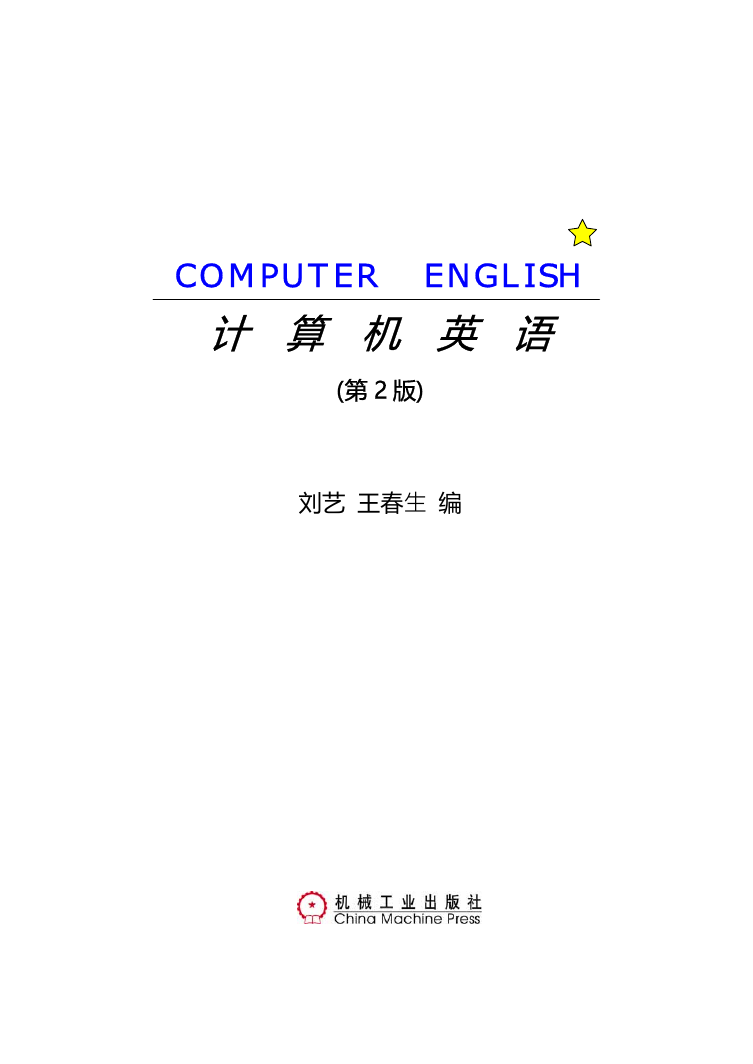
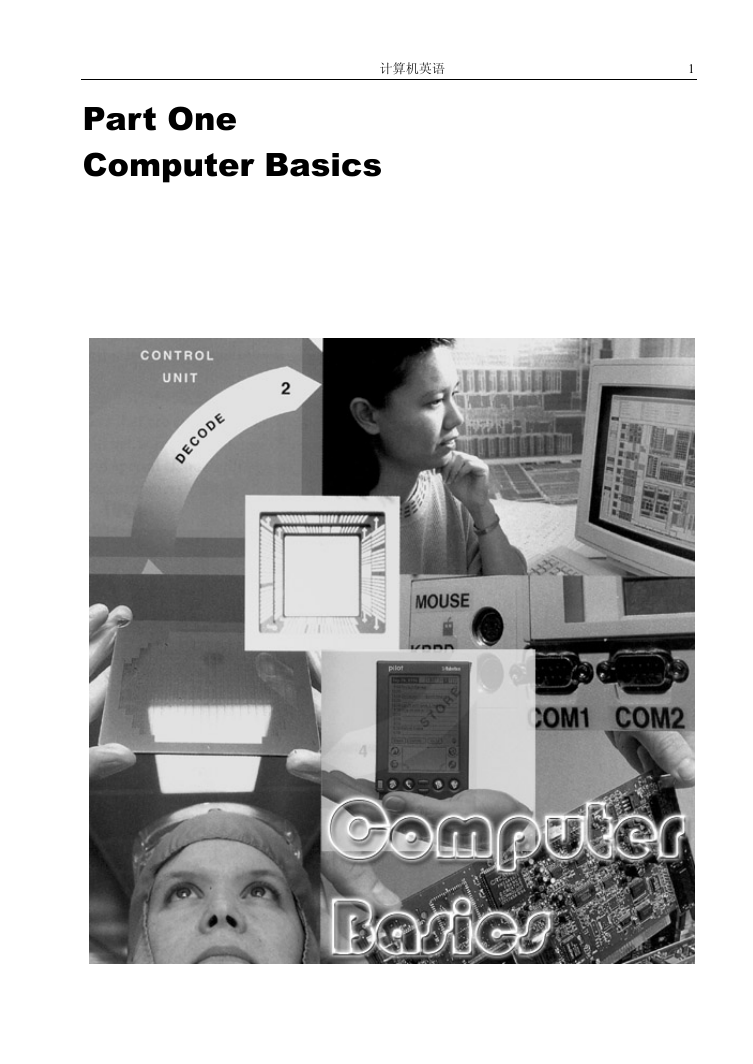
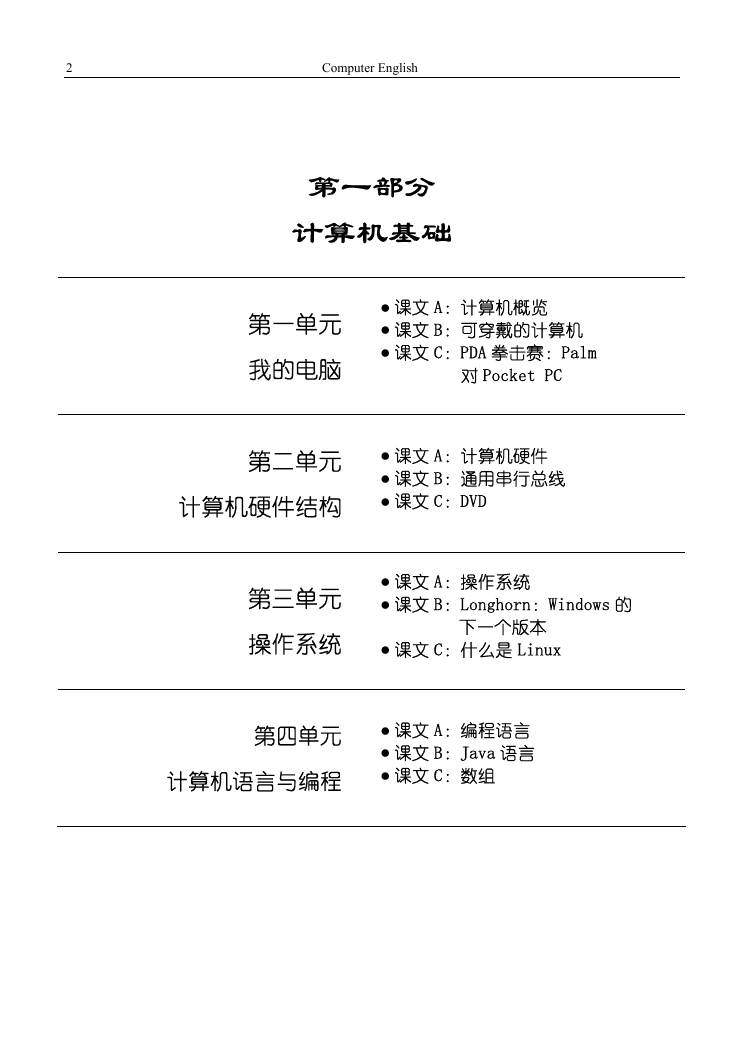
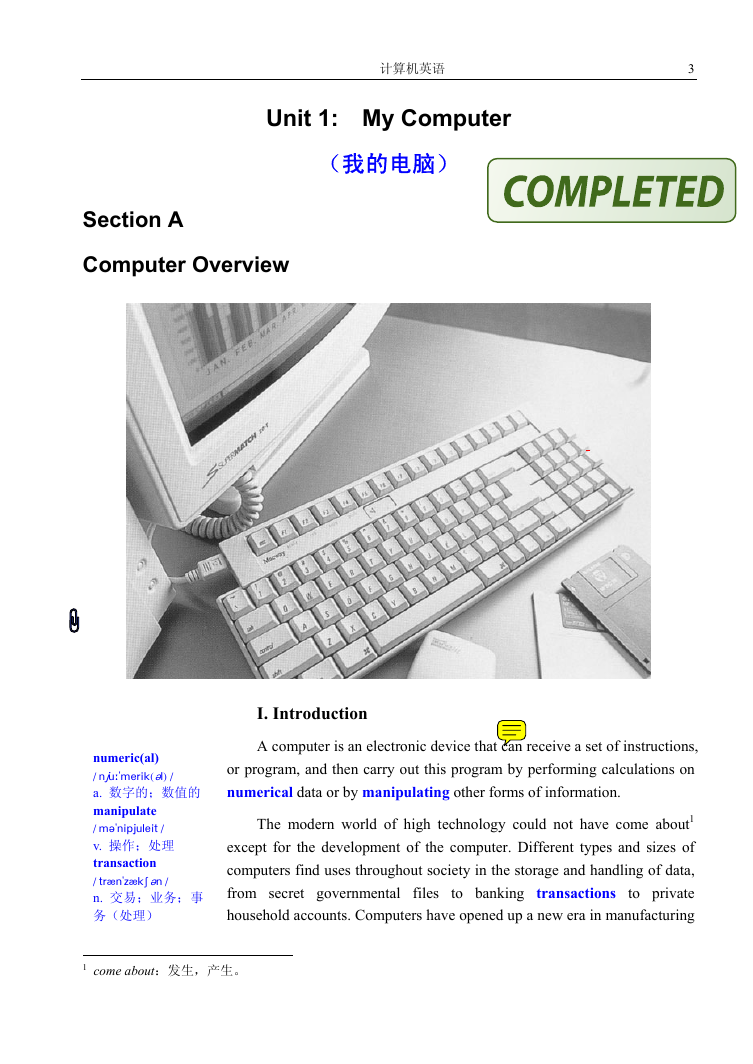
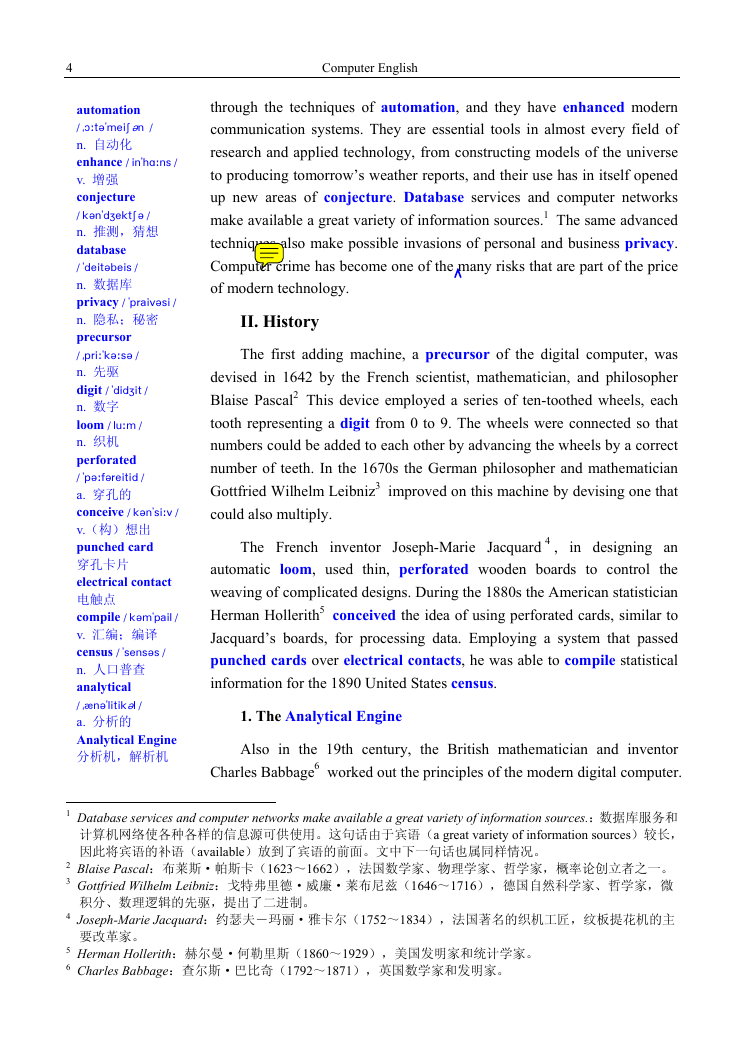

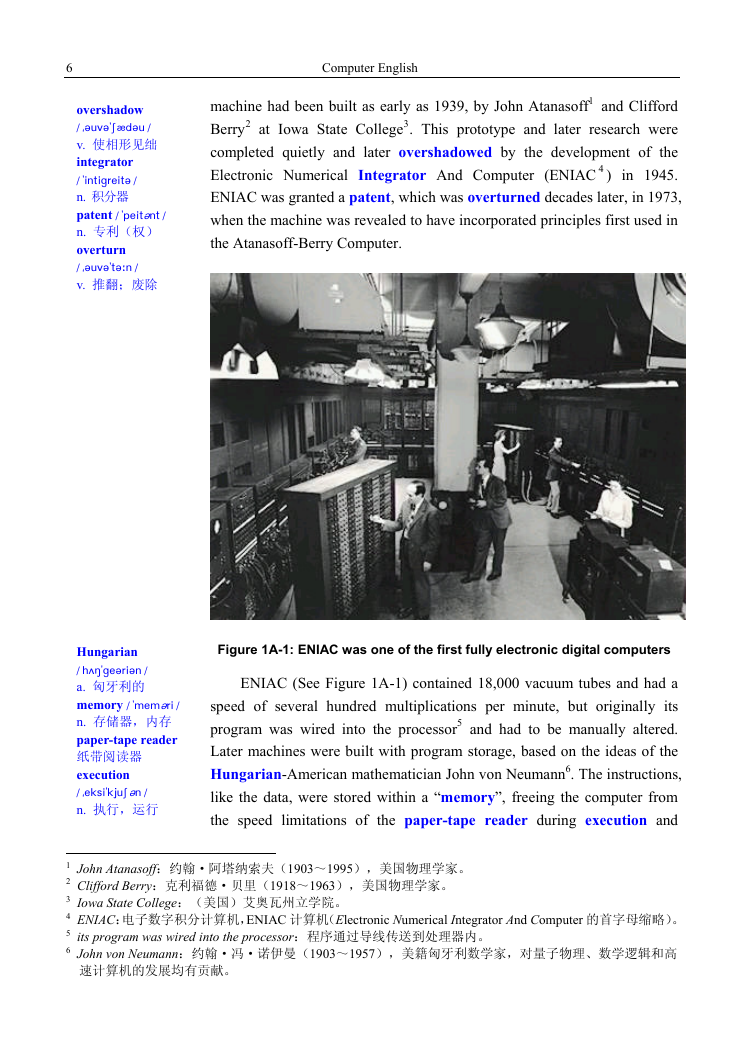
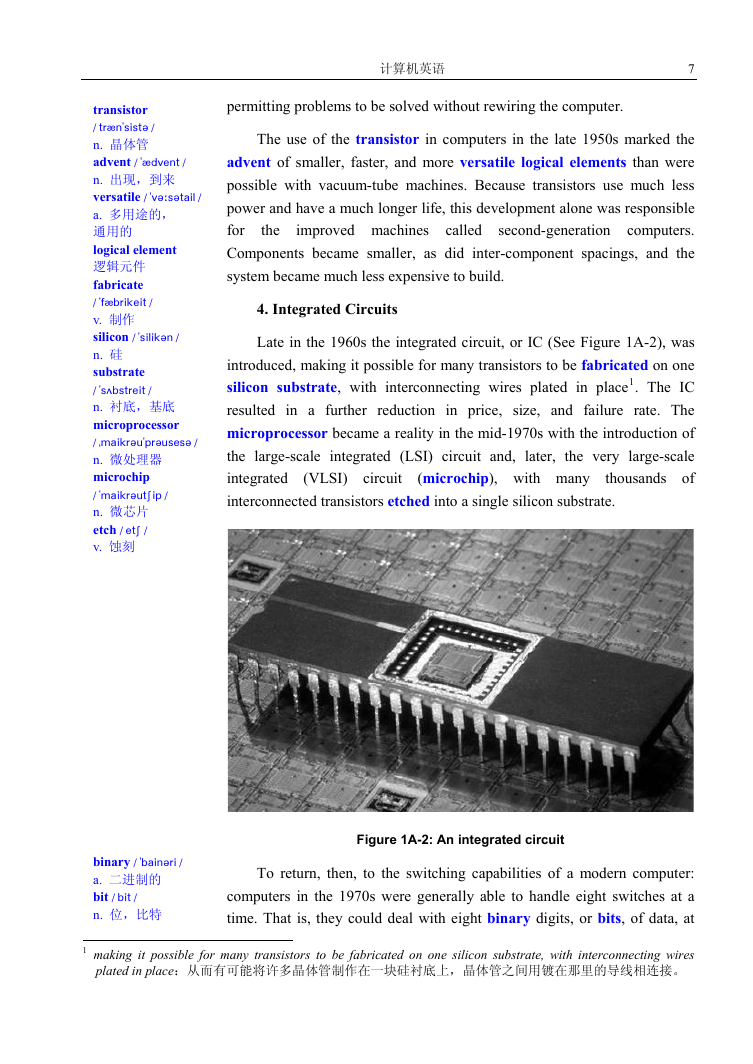








 2023年江西萍乡中考道德与法治真题及答案.doc
2023年江西萍乡中考道德与法治真题及答案.doc 2012年重庆南川中考生物真题及答案.doc
2012年重庆南川中考生物真题及答案.doc 2013年江西师范大学地理学综合及文艺理论基础考研真题.doc
2013年江西师范大学地理学综合及文艺理论基础考研真题.doc 2020年四川甘孜小升初语文真题及答案I卷.doc
2020年四川甘孜小升初语文真题及答案I卷.doc 2020年注册岩土工程师专业基础考试真题及答案.doc
2020年注册岩土工程师专业基础考试真题及答案.doc 2023-2024学年福建省厦门市九年级上学期数学月考试题及答案.doc
2023-2024学年福建省厦门市九年级上学期数学月考试题及答案.doc 2021-2022学年辽宁省沈阳市大东区九年级上学期语文期末试题及答案.doc
2021-2022学年辽宁省沈阳市大东区九年级上学期语文期末试题及答案.doc 2022-2023学年北京东城区初三第一学期物理期末试卷及答案.doc
2022-2023学年北京东城区初三第一学期物理期末试卷及答案.doc 2018上半年江西教师资格初中地理学科知识与教学能力真题及答案.doc
2018上半年江西教师资格初中地理学科知识与教学能力真题及答案.doc 2012年河北国家公务员申论考试真题及答案-省级.doc
2012年河北国家公务员申论考试真题及答案-省级.doc 2020-2021学年江苏省扬州市江都区邵樊片九年级上学期数学第一次质量检测试题及答案.doc
2020-2021学年江苏省扬州市江都区邵樊片九年级上学期数学第一次质量检测试题及答案.doc 2022下半年黑龙江教师资格证中学综合素质真题及答案.doc
2022下半年黑龙江教师资格证中学综合素质真题及答案.doc